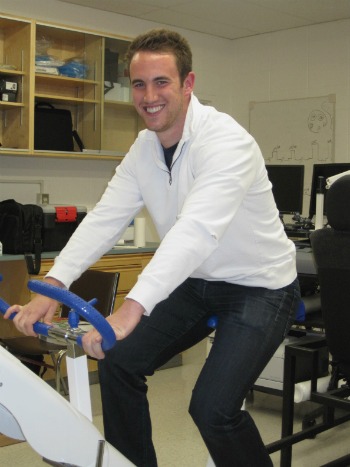
Master's student Duncan Raymond is working with exercise physiologist Darren DeLorey on a study examining how exercise helps protect the heart
How does exercise and being "physically fit" protect us from cardiovascular disease? A new study examining the effects of fitness on sympathetic nervous system activity (the part of the nervous system responsible for the flight or fight response) and its control of the circulatory system while resting and during exercise is investigating this question - but it needs a few good men.
"We're looking for men aged 18 to 30 years who are sedentary," says master's student Duncan Raymond, who is working on the study with exercise physiologist Dr. Darren DeLorey. They're hoping to prove their hypothesis that people who are more physically fit have a reduced cardiovascular and nervous system response to stress.
For the study, they're looking at three groups: high performance athletes who train rigorously for competition, moderately fit men who work out but aren't in the elite category and men who typically don't work out much or are sedentary, but not obese. It's the latter group the researchers are struggling to find.
But the benefits of being part of the study could be life changing. For starters, participants will get a clear picture of their fitness levels, says Raymond. "You'll be able to see your cardiovascular response to stress, know your baseline heart rate and blood pressure and understand your cardiovascular health and fitness. In fact, for those in the study who want to increase their fitness levels, we're also prepared to provide them with guidance to help them get started on an effective exercise regimen to improve their cardiovascular health."
The study runs over four non-consecutive days for one to two hours on each day. Participants will be put through their paces in a variety of tests to gauge their fitness level and to measure their blood flow.
Day one starts with the VO2 max test, the quintessential fitness measure. "We do this to quantify our participants' fitness," says Raymond. The test, performed on a stationary bike, gradually increases the intensity of exercise until the participant is fatigued.
One day two, "we do a maximal test on a knee extension ergometer," explains Raymond. This exercise also begins gradually and increases until the participant has to stop because of fatigue.
Day three involves examination of the sympathetic nervous system and cardiovascular response to two physiological stressors (in one the participant immerses his hand in ice water for three minutes and in the second they squeeze a hand grip device at 40 per cent of their maximal strength) under 'resting' conditions.
On day four the researchers put it all together. "Participants are exposed to the stressors while exercising," says Raymond. "We use knee extension exercise because it allows us to measure leg blood flow and calculate vascular resistance using Doppler ultrasound technology. We image the femoral artery to a measure the size of the artery and also record the velocity of the blood moving through it."
If you'd like to have more information about how to join the study, contact Duncan Raymond at draymond@ualberta.ca. Tests are conducted in room E4-39, Van Vliet Centre.